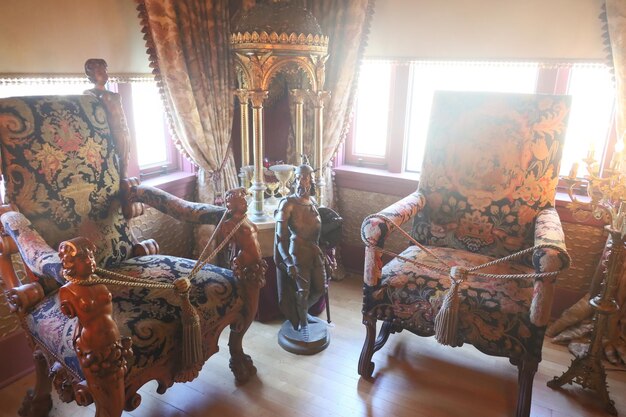Catherine the Great Furniture: A Legacy of Opulence and Innovation in Design

Introduction
Catherine the Great, the renowned Empress of Russia, was more than just a powerful ruler; she was an ardent patron of the arts, leaving an indelible mark on Russian culture and history. Her appreciation for art and design extended to her grand taste in furniture, which reflected both opulence and sophistication. “Catherine the Great furniture” symbolizes an era of lavish decor and innovative craftsmanship, blending European influence with unique Russian elements. Her collection, preserved in Russia’s grand palaces, showcases her love for luxury and her refined sense of style. This article dives into the intriguing world of Catherine the Great’s furniture, exploring its unique features, historical significance, and lasting impact on furniture design.
1. The Historical Significance of Catherine the Great’s Furniture Collection
Catherine the Great reigned from 1762 to 1796, overseeing an era of cultural and artistic renaissance in Russia. She encouraged the import of French and Italian artists and designers, leading to a fusion of Russian and European aesthetics. Her taste in furniture went beyond personal preference; it symbolized Russia’s burgeoning cultural identity. She believed in showcasing Russia as a refined European power, and her furniture choices reflected this desire to blend Russian tradition with European sophistication.
2. Key Features of Catherine the Great’s Furniture Style
Catherine’s furniture was marked by several distinctive elements, including:
- Lavish Ornamentation: Her furniture often featured intricate gold leaf, floral motifs, and delicate carvings.
- Bold Use of Color: Rich colors such as deep reds, greens, and blues were popular, adding vibrancy to her interiors.
- Exotic Materials: Catherine’s furniture used rare and expensive materials like mahogany, ebony, and marquetry inlay, symbolizing luxury.
- French Rococo Influence: She had a particular fondness for the Rococo style, known for its playful curves and light-hearted elegance, which contrasted with the earlier, more austere Baroque style.
These elements created a distinct visual language, merging Eastern opulence with Western refinement.
3. Influence of French Rococo and Neoclassicism
Catherine was particularly fond of French Rococo, with its asymmetrical designs, light colors, and curvaceous forms. However, she also embraced the neoclassical style later in her reign, influenced by her admiration for ancient Greece and Rome. This blend brought a unique aesthetic to her furniture collection, combining the grandeur of neoclassicism with the playfulness of Rococo. The neoclassical trend highlighted symmetry, restrained ornamentation, and straight lines, contrasting Rococo’s ornate designs. This transition reflected Catherine’s maturity as a ruler and her evolving taste.

4. The Role of Craftsmen and Artisans in Catherine’s Court
Catherine’s patronage extended to both Russian and European craftsmen, whom she employed to create unique pieces that would rival any European court. She invited artisans from France, Italy, and England, fostering a multicultural design approach. Russia’s indigenous talent was also encouraged, leading to a distinctive blend of craftsmanship techniques. Some notable craftsmen included:
- David Roentgen: A German cabinetmaker whose intricate mechanical tables and desks fascinated the Empress.
- Andrei Voronikhin: A Russian architect and designer known for his detailed and neoclassical work.
These artisans produced exquisite pieces with a blend of Russian materials and European techniques, cementing Catherine’s legacy as a champion of the arts.
5. Famous Pieces in Catherine the Great’s Furniture Collection
Some of the most iconic pieces of Catherine’s collection include:
- The Mechanical Table by Roentgen: This table was a marvel of its time, featuring hidden compartments and elaborate inlays, representing both artistry and engineering.
- The Malachite Room Furniture: Known for its striking green hue and luxurious material, the furniture in this room embodied her love for precious stones and Russian minerals.
- Porcelain Cabinetry: Catherine was a known collector of fine porcelain, often using her collection as part of her room decor to add an elegant, light texture to her interiors.
6. The Legacy of Catherine the Great’s Furniture Style
Today, Catherine’s furniture legacy continues to inspire luxury furniture design. Her collection, preserved in places like the Hermitage Museum and the Catherine Palace, has become a testament to her appreciation for beauty and quality. Many designers and furniture makers draw from her style, using ornate details, neoclassical influence, and exotic materials that reflect her lavish aesthetic.
7. Preserving Catherine’s Furniture Collection
Preservation efforts for Catherine’s furniture are extensive, ensuring that her pieces remain as stunning as they were centuries ago. The Hermitage Museum in St. Petersburg and the Catherine Palace house many of these iconic pieces, and careful restoration work continues to maintain their grandeur. Each piece is a historical artifact, representing Catherine’s influence on Russian culture and her vision for her nation’s artistic heritage.

Conclusion
Catherine the Great’s furniture collection remains a timeless symbol of luxury, artistic innovation, and cultural amalgamation. Her influence on furniture design endures, inspiring both historical study and modern luxury trends. Catherine’s pieces are more than functional items; they are embodiments of her vision, love for art, and ambition for Russia’s cultural prominence. From French Rococo to Russian craftsmanship, Catherine’s style reflects a unique blend of tradition and innovation. Her legacy continues to shape the world of design, reminding us that furniture can tell powerful stories of history, taste, and identity. Catherine the Great Furniture.
FAQs
- What styles influenced Catherine the Great’s furniture? Catherine’s furniture was mainly influenced by French Rococo and neoclassicism, blending Russian craftsmanship with European elegance.
- Where can I see Catherine the Great’s furniture? You can view her collection in the Hermitage Museum and the Catherine Palace in St. Petersburg, Russia.
- Who were some of the artisans she employed? Notable artisans included German cabinetmaker David Roentgen and Russian architect Andrei Voronikhin.
- What materials were used in Catherine’s furniture? Catherine’s furniture featured luxurious materials such as mahogany, ebony, malachite, and intricate marquetry inlay.
- How did Catherine’s furniture influence Russian design? By blending European and Russian styles, Catherine’s collection set a precedent for incorporating opulence and innovation in Russian furniture design.
- Is Catherine the Great’s furniture still relevant today? Absolutely. Catherine’s style inspires modern luxury furniture designs, especially those that emphasize rich materials and detailed craftsmanship.

